Parasitic Disease
Estimation of the prevalence of Giardia spp parasitein cattle farms in France based on data from the 3VCOCS service
Tom STRYDOM, Clara BOUREL, Guillaume LEQUEUX, Damien CHEREL, Léa MIROW, Cyril DELORY
Cysts or trophozoites of Giardia were found in a quarter of the studied farms and twice as many dairy are affected than beef farms. RITCHIE’s method allows for better detection of cysts but is not suitable for highlighting trophozoites. The direct examination method with Lugol staining of a pool is less sensitive than the individual method (sensitivity 60%). However repeated sampling over time could be a means to increase its sensitivity.
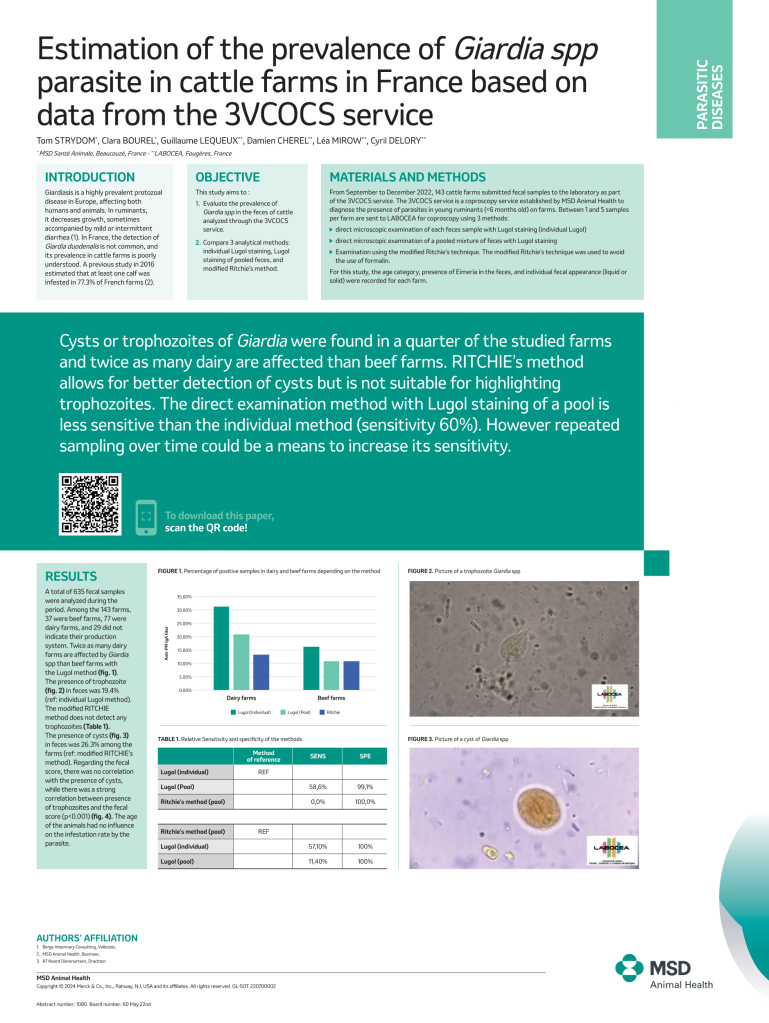
Effect of Potassium Sorbate on Cryptosporidium GP40 antibodies in colostrum
Geert Vertenten, Hanny Swam, Nigel Gulickx, Jules Petit, Bart Sustronck, Mark van Roosmalen
The addition of a potassium sorbate solution to colostrum has no negative effect on the amount of Cryptosporidium Gp40 antibodies in colostrum. In this trial, it has been reconfirmed that the addition of potassium sorbate is an effective way to conserve colostrum at room temperature
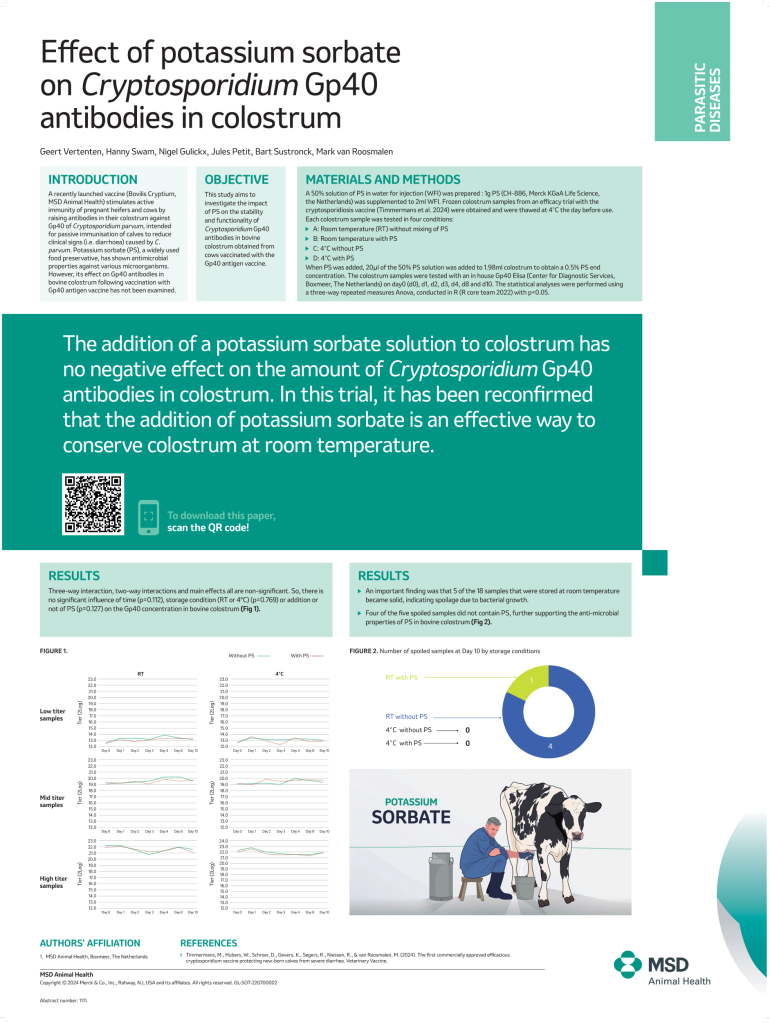
Two clinical studies to evaluate the efficacy of a novel subunit vaccine in the reduction of clinical signs (i.e. diarrhea) caused by C. parvum infections in neonatal calves
Martine J.S. Reijnders1, Mark van Roosmalen2, Hans Holtslag1 Susan Arts1, Suzanne Pel1, Divine M. Dufé3, Marianne J. Kaashoek2, G. Vertenten4, Alfredo Teixeira5, T. van Werven6, S. Sietsma6, C. Roy7, N. Herman7
The newly developed Gp40 vaccine is efficacious
in mitigating the impact of C. parvum caused diarrhea
in neonatal calves.
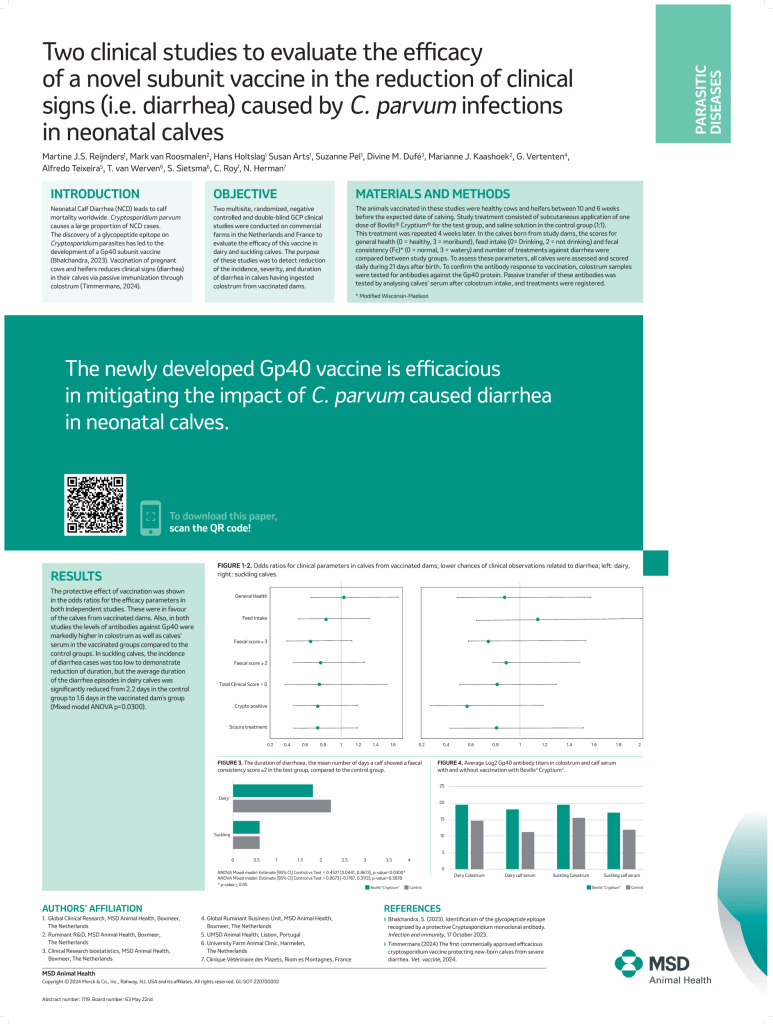
Evaluation of anti-GP40 serological titers of Cryptosporidium parvum in French beef cattle
Clara BOUREL, Thibault JOZAN , Geert VERTENTEN, André PRETO
The serological titers of anti-Gp40 antibodies in French
beef cattle remained stable along the period from the first
to the last sample. These titers were low and comparable
to those of the control group in the publication by Timmermans et al. 2024.
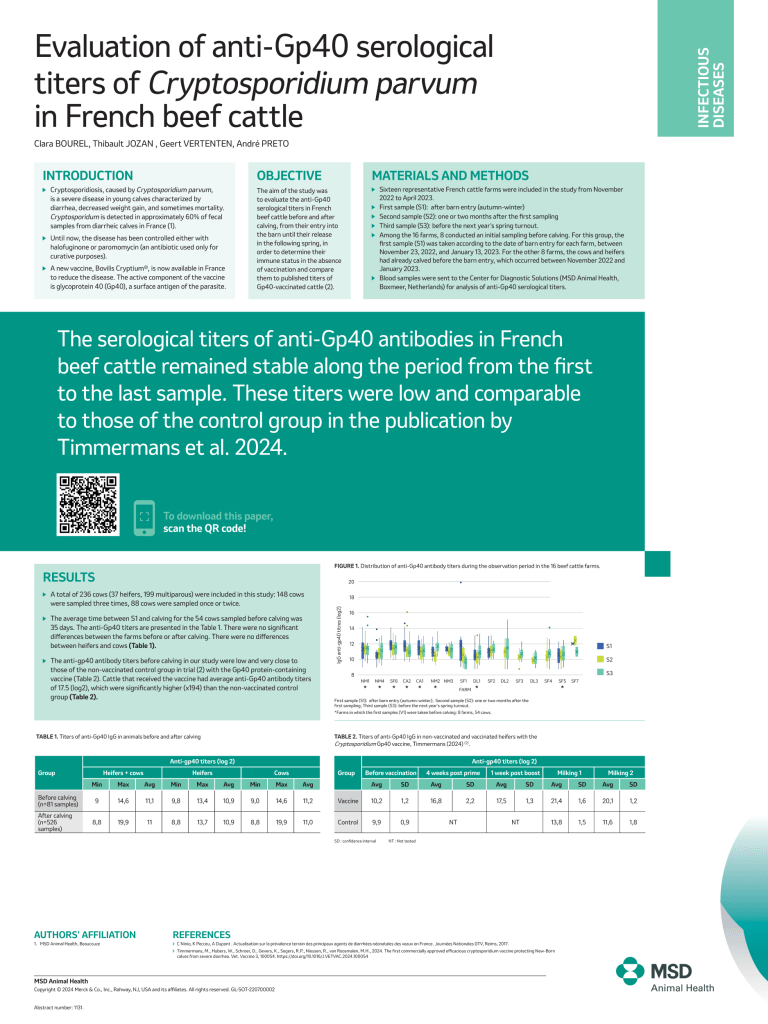
Efficacy report of a fluralaner pour-on product against common ectoparasites infesting cattle in Brazil
Daniel Rodriques4, Tom Strydom4 , AJ Costa1, JRS Martins2, Fernado Borges3, Luis Vettorato4, Francisco Barufi4, Heitor Amaral4, Luara Abujarma4, WDZ Lopes5
Overall results from these studies confirm that Exzolt® 5% provides a therapeutic efficacy against the most important ectoparasites infesting cattle in Brazil, along with an impressive persistent efficacy against re-infestation. The novel active pharmaceutical ingredient, fluralaner, provides a new treatment option for farmers to control these cattle ectoparasites, especially where there is resistance to other chemical classes. An effective control of ectoparasites, in turn, will improve overall cattle health, well-being and production.
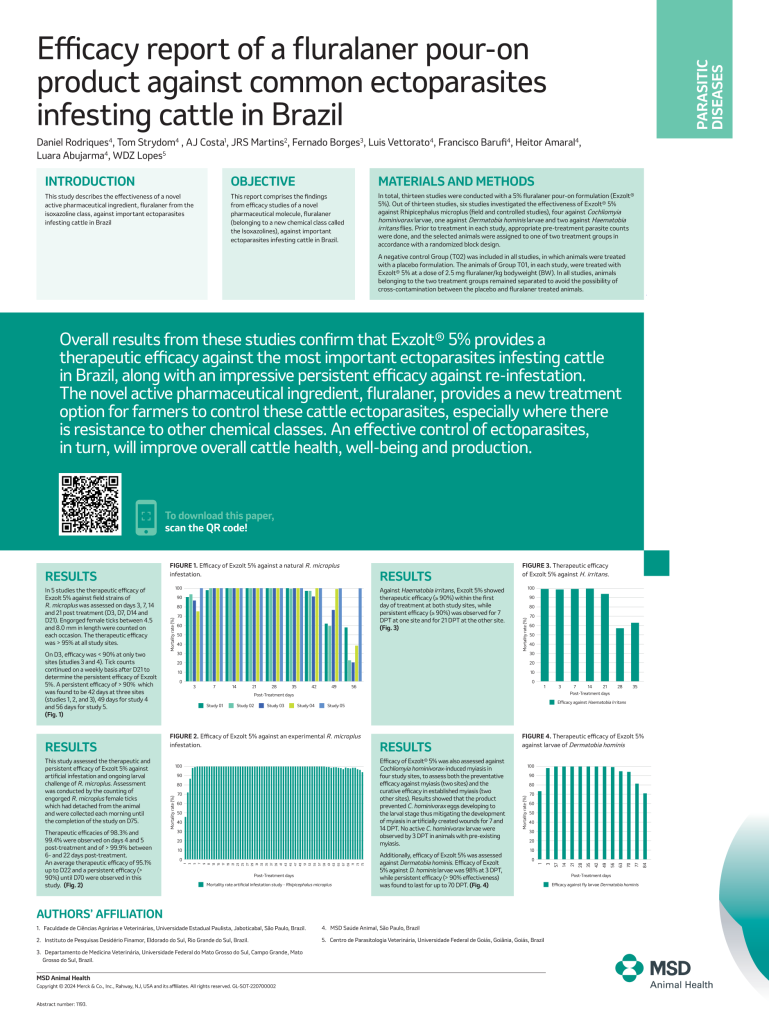
Different strategies for using fluralaner pour-on product (Exzolt 5%) to control Rhipicephalus microplus on taurine cattle breeds in a tropical region of Brazil
Daniel Rodriques1,2, Tom Strydom3 , LM de Aquino1, DMB Zapa1, Siddartha Torres-Rico4, L L Ferreira5, Francisco Barufi2, Heitor Amaral2, Fernado Borges6,
Tiago Gallina7, R P Mendonca8, V E Soares9, C M O Monteiro1,10, WDZ Lopes1,10
The study showed that depending on the treatment criteria, adopted for the re-treatment of tick infested cattle with Exzolt 5%, the number of product administrations per year could be lower to control R. microplus ticks than traditional treatment protocols. The reduced frequency of re-treatment would translate into not only a reduction in the average cost of acaricide treatments per year but will also reduce the exposure of R. microplus populations to the active ingredient resulting
in slowing-down resistance development.
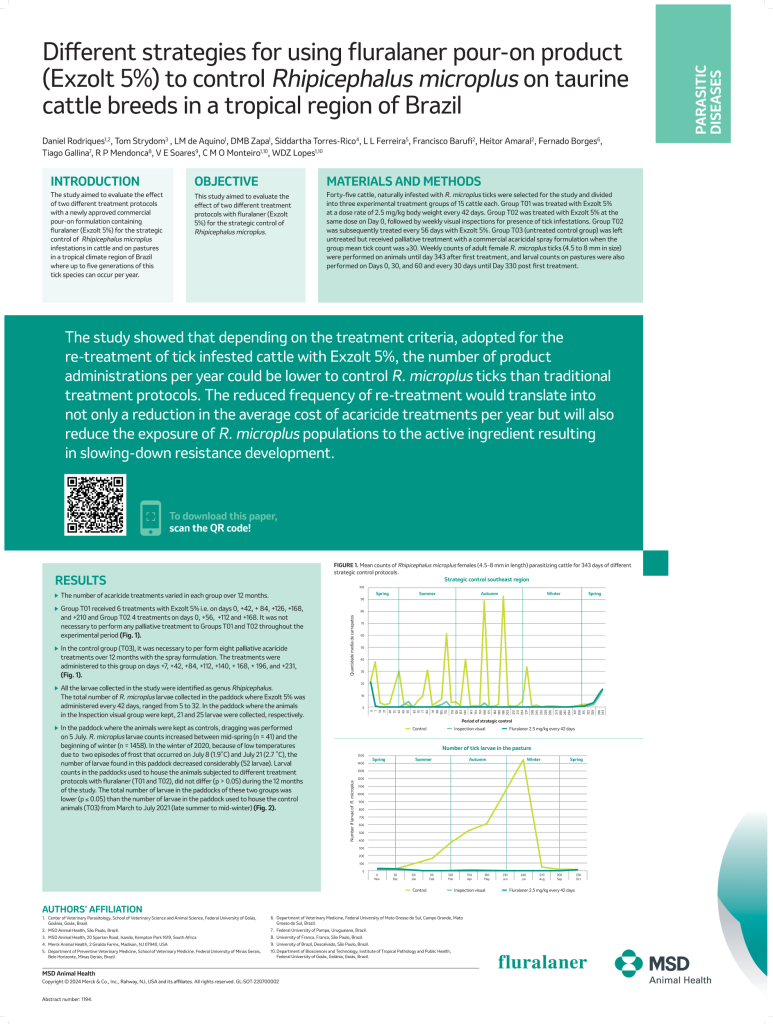
Strategic control of Rhipicephalus microplus in taurine cattle breeds with fluralaner (Exzolt 5%) in a subtropical region of Brazil
Daniel Rodriques4, Tom Strydom5 , Tiago Gallina1, L S Lagranha1, G Bilo1, C Malavolta1, L L Ferreira2, Fernado Borges3, Siddartha Torres-Rico6, WDZ Lopes7
Administration of a fluralaner (EXZOLT® 5%), administered during summer and autumn seasons, with 42-day intervals between treatments, was effective in the strategic control of R. microplus. Besides the high efficacy against ticks, animals subjected to the strategic control with fluralaner showed no incidence of screwworm (myiasis) infestations and consequently gained 32.8 kg more weight than untreated cattle during the experimental period.
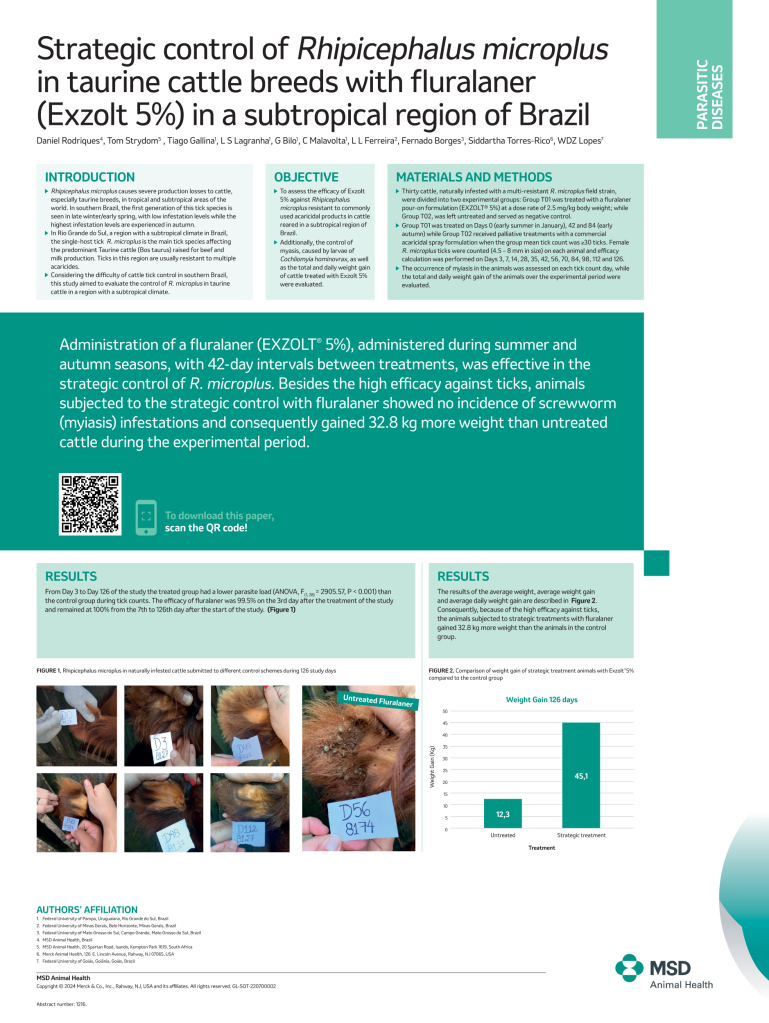
Identifying when anticoccidial metaphylaxis should be applied in Spanish dairy and meat sheep farms
Lourdes Brandariz-Amores1, Jorge Gutiérrez2, José Luis Blasco-Castello2, Laura Elvira2, Luis Miguel Ortega-Mora1, Ignacio Ferre1
Monitoring parasitological and clinical parameters
in a group of sentinels is an interesting tool to determine the optimal time to apply metaphylactic treatment
with diclazuril and management strategies.
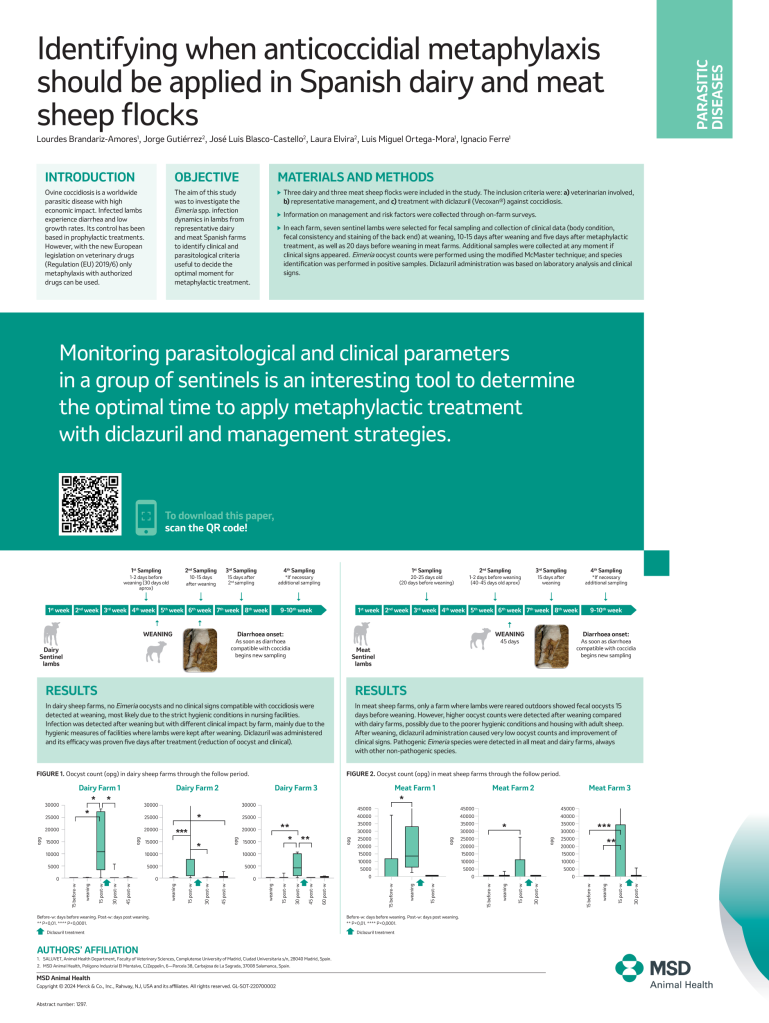
Preventative/Prophylactic activity of isometamidium against Trypanosoma vivax in experimentally infected cattle in Brazil
Daniel Rodriques2, Tom Strydom3 , DMB Zapa1, L M Heller1, Lidia Mendes de Aquino1, WDZ Lopes1, Luis Vettorato2, Heitor Amaral2, Francisco Barufi2
It can be concluded that the product Trypamizol®, administered intramuscularly to cattle at a dose of 1 mg isometamidium/kg body weight, showed 100% prophylactic activity for 90 days against Trypanosoma vivax in experimentally infected cattle.

Enzootic stability of tick fever in dairy calves submitted to strategic cattle tick control with fluralaner in Brazil
Daniel Rodriques 1,4, Tom Strydom 5 , DMB Zapa 1, L M Aquino 1, L F M Couto 1, L M Heller 1, I M L Morais 1, V F Salvador 1, L L L L Leal 1, W V F Paula 2, N J Lima 2, L L Ferreira 3, Siddartha Torres-Rico 6, V E Soares 7, F S Krawczak 2, W D Z Lopez 1,8
In addition to its significant efficacy in controlling R. microplus, fluralaner did not affect the enzootic stability status of A. marginale and B. bigemina in the herd in this study. The stability status of B. bovis was inconclusive because few animals of both groups tested positive for this protozoan species possibly due to a lower infection rate of ticks on the farm. However, further studies will have to be conducted to show the longterm effect of successful tick control with fluralaner on enzootic stability of babesiosis in cattle in Brazil.


